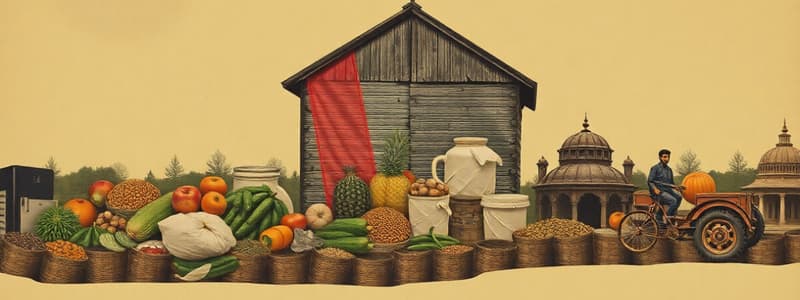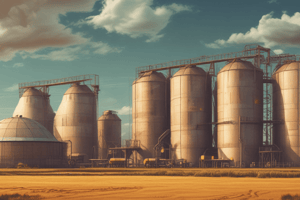Podcast
Questions and Answers
Which factor primarily contributes to chronic hunger among poor people?
Which factor primarily contributes to chronic hunger among poor people?
- Inability to buy food due to very low income. (correct)
- Seasonal nature of agricultural activities.
- Adverse weather conditions affecting crop yields.
- Lack of access to government ration shops.
Seasonal hunger is more prevalent in urban areas due to the consistent availability of work throughout the year.
Seasonal hunger is more prevalent in urban areas due to the consistent availability of work throughout the year.
False (B)
What is the main objective of maintaining a buffer stock of food grains?
What is the main objective of maintaining a buffer stock of food grains?
To distribute food grains in deficit areas, to help resolve food shortages during adverse conditions, and to maintain price stability.
The government announces the ________ every year before the sowing season to incentivize farmers.
The government announces the ________ every year before the sowing season to incentivize farmers.
Match the following terms with their descriptions:
Match the following terms with their descriptions:
Which of the following states is NOT mentioned as having a large number of food-insecure people?
Which of the following states is NOT mentioned as having a large number of food-insecure people?
The 'Wheat Revolution' stamp was released in 1978 to commemorate the Green Revolution's success.
The 'Wheat Revolution' stamp was released in 1978 to commemorate the Green Revolution's success.
What is the primary role of the Food Corporation of India (FCI)?
What is the primary role of the Food Corporation of India (FCI)?
Which of the following scenarios best illustrates the concept of 'accessibility' within the context of food security?
Which of the following scenarios best illustrates the concept of 'accessibility' within the context of food security?
According to Amartya Sen's perspective on food security, simply having enough food available is sufficient to ensure food security for a population.
According to Amartya Sen's perspective on food security, simply having enough food available is sufficient to ensure food security for a population.
Explain how a drought can lead to a situation of famine in a region.
Explain how a drought can lead to a situation of famine in a region.
People belonging to the Scheduled Castes (SCs), Scheduled Tribes (STs), and some sections of the Other Backward Classes (OBCs) are prone to food insecurity because they often have poor ______.
People belonging to the Scheduled Castes (SCs), Scheduled Tribes (STs), and some sections of the Other Backward Classes (OBCs) are prone to food insecurity because they often have poor ______.
Match the following groups with their primary reason for food insecurity:
Match the following groups with their primary reason for food insecurity:
Which of these factors contribute to a family being classified as 'food insecure' in urban areas?
Which of these factors contribute to a family being classified as 'food insecure' in urban areas?
Food security is only a concern during times of national disaster or widespread calamity.
Food security is only a concern during times of national disaster or widespread calamity.
Which of the following is the primary objective of the Public Distribution System (PDS) in India?
Which of the following is the primary objective of the Public Distribution System (PDS) in India?
Briefly describe how the government's granaries play a role in ensuring food availability component of food security.
Briefly describe how the government's granaries play a role in ensuring food availability component of food security.
Ration shops under the Public Distribution System (PDS) sell goods exclusively at market prices.
Ration shops under the Public Distribution System (PDS) sell goods exclusively at market prices.
Name three essential commodities typically sold at ration shops under the Public Distribution System (PDS) in India.
Name three essential commodities typically sold at ration shops under the Public Distribution System (PDS) in India.
The Public Distribution System in India dates back to rationing during the 1940s against the backdrop of the _______.
The Public Distribution System in India dates back to rationing during the 1940s against the backdrop of the _______.
What is a common malpractice associated with PDS dealers?
What is a common malpractice associated with PDS dealers?
The Minimum Support Price (MSP) and procurement system under the PDS have negatively impacted food grain production in India.
The Minimum Support Price (MSP) and procurement system under the PDS have negatively impacted food grain production in India.
Match the ration card type with its intended beneficiary:
Match the ration card type with its intended beneficiary:
What role do cooperative societies play in food security, particularly in southern and western India?
What role do cooperative societies play in food security, particularly in southern and western India?
Flashcards
Food Insecurity
Food Insecurity
A situation where people lack reliable access to sufficient food.
Chronic Hunger
Chronic Hunger
A long-term lack of adequate food quantity and quality.
Seasonal Hunger
Seasonal Hunger
Temporary hunger due to seasonal cycles of food production.
Green Revolution
Green Revolution
Signup and view all the flashcards
Buffer Stock
Buffer Stock
Signup and view all the flashcards
Minimum Support Price (MSP)
Minimum Support Price (MSP)
Signup and view all the flashcards
Public Distribution System
Public Distribution System
Signup and view all the flashcards
Food Corporation of India (FCI)
Food Corporation of India (FCI)
Signup and view all the flashcards
Availability
Availability
Signup and view all the flashcards
Accessibility
Accessibility
Signup and view all the flashcards
Affordability
Affordability
Signup and view all the flashcards
Entitlements
Entitlements
Signup and view all the flashcards
Food Insecure
Food Insecure
Signup and view all the flashcards
Vulnerable Groups
Vulnerable Groups
Signup and view all the flashcards
Natural Calamities
Natural Calamities
Signup and view all the flashcards
Public Distribution System (PDS)
Public Distribution System (PDS)
Signup and view all the flashcards
Ration Shops
Ration Shops
Signup and view all the flashcards
Types of Ration Cards
Types of Ration Cards
Signup and view all the flashcards
Antyodaya Cards
Antyodaya Cards
Signup and view all the flashcards
Limitations of PDS
Limitations of PDS
Signup and view all the flashcards
Role of Cooperatives
Role of Cooperatives
Signup and view all the flashcards
Study Notes
Food Security in India
-
Food security is the availability, accessibility, and affordability of safe and nutritious food for all people at all times.
-
Entitlements to food, as conceptualized by Amartya Sen, emphasizes access to food.
-
Food insecurity often affects the poorest segments of society, particularly during national emergencies or natural disasters.
-
Natural calamities, such as droughts, significantly reduce food production, leading to shortages and price increases, potentially causing widespread starvation or famine.
-
Landless people, traditional artisans, petty workers, and destitute, in rural areas, and unskilled laborers in urban areas, are highly vulnerable to food insecurity.
-
Societal groups, particularly Scheduled Castes (SCs), Scheduled Tribes (STs), and some Other Backward Classes (OBCs), with limited land access or productivity, are also at high risk.
-
Regions prone to natural disasters experience greater food insecurity.
-
Women and children (under 5 years old) are a large portion of the food-insecure population, including pregnant and nursing mothers.
-
Food insecurity is also indicated by chronic and seasonal hunger. Chronic hunger stems from inadequate food quantity and quality, often due to poverty. Seasonal hunger is temporary, linked to agricultural cycles in rural areas or job scarcity in urban ones.
-
India has initiatives to increase food security, such as the Green Revolution, aimed at increasing wheat and rice production.
-
The government maintains buffer stocks of food grains, purchased from surplus producing states, to ensure availability during shortages.
-
The Public Distribution System (PDS) distributes these food grains at subsidized prices to vulnerable groups through ration shops across the country.
-
Ration cards are categorized into different types: Antyodaya, BPL (Below Poverty Line), APL (Above Poverty Line), and PHH (Priority Households).
-
Cooperatives in southern and western India play a crucial role in supporting food security by establishing fair-price shops for vulnerable populations.
-
Government policies regarding minimum support price (MSP), promote farmer income.
-
The Academy of Development Science (ADS) is using grain banks to improve food security.
Studying That Suits You
Use AI to generate personalized quizzes and flashcards to suit your learning preferences.




